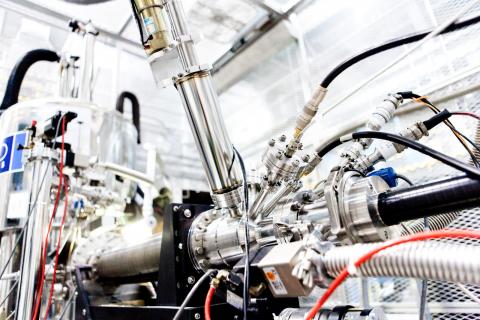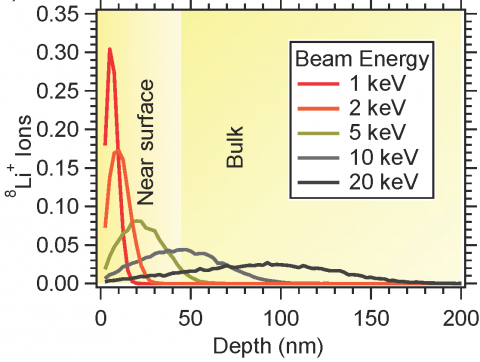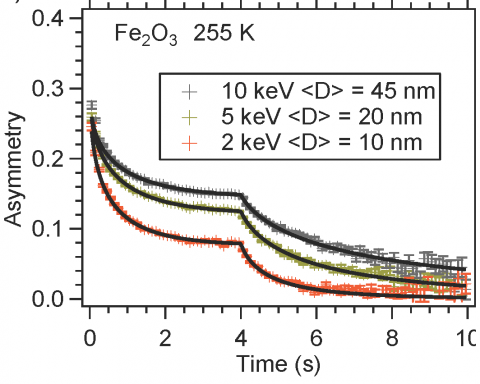


Magnetism permeates every scale of TRIUMF life, from the cyclotron’s 17m diameter main magnet down five orders of magnitude to the tiny internal magnetic fields inside millimetre-sized samples probed by μSR (muon spin rotation/resonance/relaxation) experiments, all the way down to probing materials at the tens of nanometre scale with the βNMR (beta-delayed nuclear magnetic resonance) facility. Scientists working at βNMR (see Figure 1) have been quietly making breakthroughs in the magnetic characterization of nanostructures near material interfaces. Their most recent result, published in the prestigious journal Physical Review Letters, has identified a new phenomenon in the near-surface behaviour of a prototypical antiferromagnet which cannot be classified according to the standard behaviour hierarchy.
Most everyday magnets are ferromagnets like iron, whose internal “magnetic domains” (tiny bar magnet-like regions within the larger magnet) can be made to line up preferentially in one direction to create a magnetic field outside the material. In an antiferromagnet, however, adjacent domains line-up antiparallel to each other, thereby cancelling each other’s magnetic field overall. However, unlike normal non-magnetic materials with randomized domain directions, the antiferromagnet’s antiparallel ordering can exhibit interesting behaviours at small scales, especially near material interfaces. These behaviours have been exploited, for example, by the multibillion dollar magnetic hard-drive industry.
A team of researchers led by David Cortie, Andrew MacFarlane and Robert Kiefl working at the βNMR facility at TRIUMF have made the first application of the facility’s depth-resolved ion-beam technique to detect the NMR signal from the near-surface region of an antiferromagnet. Their initial work was on the prototypical antiferromagnet α-Fe2O3 (110), which was identified as an ideal test case. In the βNMR technique, 8Li+ ions are implanted precisely underneath material surfaces at varying depths with roughly 10 nanometre precision (see Figure 2). Detecting the resulting lithium decay electron serves to enhance the NMR signal by a factor of a billion. The combination provides extreme sensitivity for characterizing local magnetic fields at nanometre scales, essential for probing such fields near material interfaces.
The group discovered new behaviour in the spin reorientation transition near the α-Fe2O3 (110) surface that did not fit within the established hierarchy of near-surface phase transitions (see Figure 3). Their results showed conclusively that βNMR can measure phase transitions, structure and dynamics near antiferromagnetic interfaces, thereby providing a new tool for optimizing functionality in novel nanostructures. βNMR looks forward to greatly increased uptime once TRIUMF’s upcoming ARIEL facility comes online, and so we can all look forward to many more breakthroughs coming from βNMR in the future.
For more information, the research paper can be found here.
Figure 1. Close-up view of the βNMR facility at TRIUMF.
Figure 2. Calculated depth stopping profile of the 8Li+ ions as a function of beam energy.
Figure 3, Spin-lattice relaxation (SLR) data as a function of beam energy and ion-implantation depth showing modified SLR for ions stopping near the α-Fe2O3 (110) surface.
